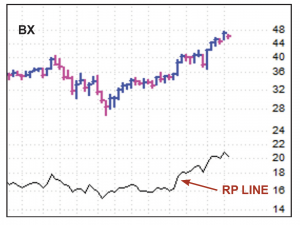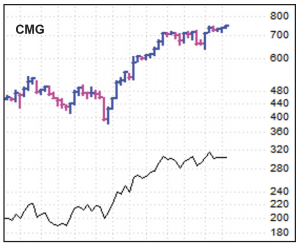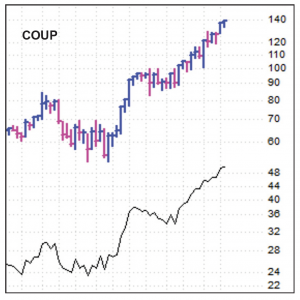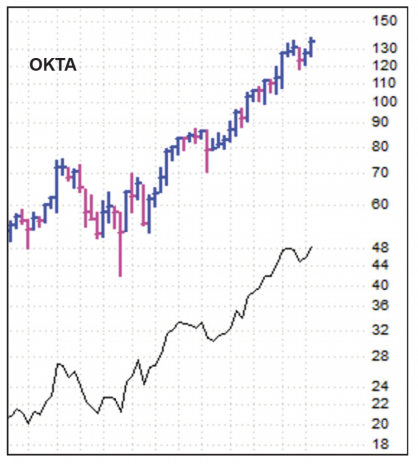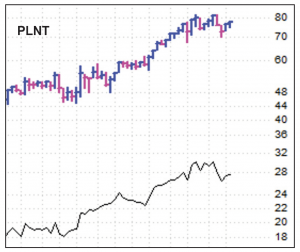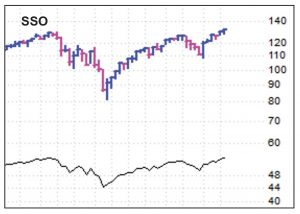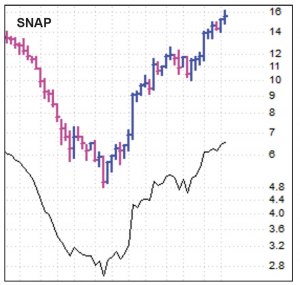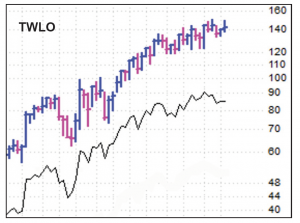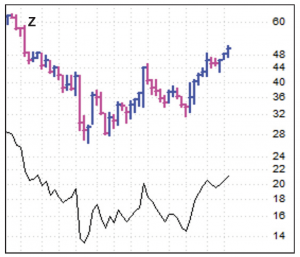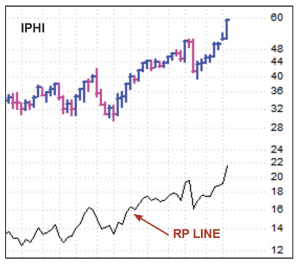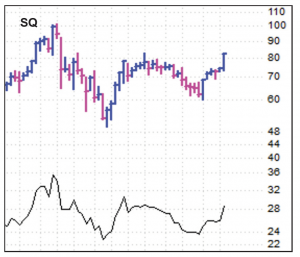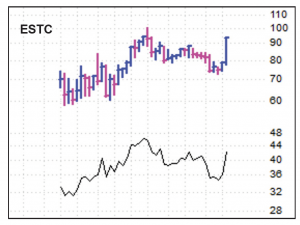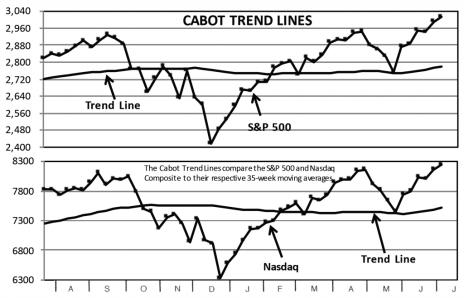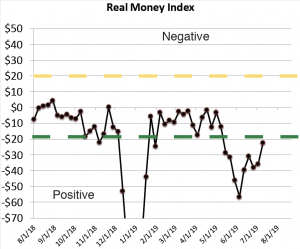In tonight’s letter, we share a couple of ideas for those of you that don’t like to hold all your stocks though earnings; we review a couple of new names that are on our watch list (ESTC is one we’re very intrigued by) and go over all our current Model Portfolio stocks as many are set to report earnings during the next two weeks.
Cabot Growth Investor 1424
[premium_html_toc post_id="182213"]
Mostly Sunny—with Possible T-Storms Along the Way
Ever since January 9, when the 2-to-1 Blastoff Indicator gave a rare buy signal just two weeks after the market’s major bottom, our greatest conviction has been that the overall market had likely entered a new bull phase that should take it nicely higher. So far, so good—ever since that indicator flashed green (along with the 90% Blastoff Indicator in February), the major indexes have put on a great show.
And despite it being six months on, nothing has changed with our thinking. In fact, over the past couple of weeks, we’ve received a couple more rare green lights that tell us this bull market has a long way to run! Our own 7.5% Rule was triggered earlier this month for just the 12th time since 1980; you can read about all the numbers on page 6, but suffice to say it’s usually led to happy days over the next six to 12 months.
What about all the shenanigans going on in the real world, from a slowing economy to trade rumors/reports to potential rate cuts to lackluster earnings growth to (we hate to say it) politics? Our job is not to predict how we think those items will play out—it’s to interpret how the market believes they will play out. Of course, there’s never any surety when it comes to stocks, but right now, it’s clear most big investors think things will turn out just fine (and possibly better than expected).
Thus, big picture, the weight of the evidence—including our market timing indicators, the action of leading stocks and the 7.5% Rule—all tell us higher prices are likely.
That said, every summer has a few thunderstorms that roll through, so we’re not advising you to throw caution to the wind. Actually, we think the near-term is a toss-up, at least when it comes to individual growth stocks— earnings season is always tricky, and let’s face it, many leaders have had great runs over the past couple of months, which could open the door to some hiccups.
Thus, we’re keeping our feet on the ground and looking for high-odds opportunities on the buy side—opportunities that have a good chance to emerge during earnings season.
[highlight_box]WHAT TO DO NOW: Remain mostly bullish. In the Model Portfolio, we’re going to put a little more money to work tonight by adding a 4% position to our ProShares Ultra S&P (SSO) stake. That will leave us with 18% in cash, which we’re aiming to deploy as some fresh leadership emerges. [/highlight_box]
Model Portfolio Update
As we wrote on page 1, we’re very optimistic about the market’s intermediate- to longer-term path—it’s a good bet we see meaningfully higher levels from the major indexes in the months ahead. However, when it comes to individual growth stocks, we’re still being choosy because few names are at great entry points, some have stalled out near prior highs and, of course, many are set to report earnings within a couple of weeks.
All told, then, we’re following the evidence—with the overall market in good shape, we’re throwing a few more dollars at our leveraged long index fund, but we’re content to hold our remaining cash (will be about 18% after the extra nibble at SSO) as we look for fresh opportunities.
Current Recommendations
BUY—Blackstone (BX 46)—Blackstone reported a fine second quarter this morning—while some of the top-line numbers were so-so (distributable earnings up just 1% year over year), the future looks very bright, as the company set a record for asset inflows (total assets under management rose 24% from last year, led by a whopping 49% gain in its private equity business). Moreover, fee-based distributable income, which is more stable than one-time realizations, gained a solid 24% and made up nearly 60% of the total. Blackstone also declared a 48-cent per share dividend, payable August 5. The stock reacted decently to the news, and while some near-term wiggles are possible after the stock’s recent advance, the overall bullish story (rising asset values thanks to huge inflows and top-notch performance) and chart (decisively broke out of a multi-year consolidation in April) are intact. If you own some, hang on, and if you don’t, we’re fine taking a position around here.
BUY—Chipotle Mexican Grill (CMG 764)—Chipotle will release its own quarterly report next Tuesday (July 23) after the closing bell; analysts are looking for revenues of $5.43 billion (up nearly 12%) and earnings of $13.08 per share (up 44%), though same-store sales will also be a key metric for big investors. Like most growth stocks, CMG isn’t tearing up the charts, but it’s acting well enough, having nosed out to new highs this week. Of course, there’s always a chance the stock craps out on earnings; a major decline back into the mid 600s would be abnormal and could have us bailing out. But we always go with the evidence in front of us, and right here the odds favor CMG’s April-June consolidation being a normal rest after a big advance, and that the stock is still early in its turnaround as the company’s various initiatives (delivery, new menu items, frequent user discounts, etc.) bear fruit. We’ll stay on Buy, though as usual, any new buys this close to earnings should be kept on the small side.
BUY—Coupa Software (COUP 146)—Despite some hesitation from a few well-known names in the cloud software space, Coupa remains a star performer, consistently pushing to new highs during the past couple of weeks. A bevy of analyst upgrades have helped the cause, most of which cite the firm’s massive opportunity as Coupa attracts more and more big fish for its cloud-based spending management platform. One of the big attractions here from a business model point of view is the ramp in business (and free cash flow) that comes after a customer is up and running on the platform—one example the firm cited showed that, while the first year saw a loss of nearly $40 million, every year after that saw cash flow north of $30 million, meaning a relatively quick and large return on investment for Coupa. Indeed, while earnings here are just north of breakeven, free cash flow was 11% of revenue last year and nearly 20% in the most recent quarter! Fundamentally, then, Coupa is set to get much, much bigger in the years ahead. Near term, the stock is extended to the upside (the 25-day line is around 131), so if you want in, aim for dips of a few points.
BUY—Okta (OKTA 137)—OKTA remains one of top leaders in the market, having shrugged off a bout of distribution in mid June and returned to new highs, albeit on sub-par volume. Given the stock’s big run in recent months (up around 60% since the start of April!), we’re still open to the possibility that shares could begin a consolidation in the near future—combined with our good-sized position, we might book partial profits if the sellers show up in a major way. However, that remains a big if; OKTA’s trend is strongly up, so we’re simply sitting tight and giving it a chance to continue higher. And even if the stock does begin a rest period, we still think the big picture is bright—the stock looks like rare merchandise for big investors, as its identity products are becoming a must-have in the world of cybersecurity as the cloud becomes the new normal. All in all, just going with the evidence, we’ll stay on Buy, though we think it’s best for new buyers to start small.
HOLD—Planet Fitness (PLNT 76)—After a wild few weeks (at least relative to its prior action), PLNT has settled down, hanging around the mid 70s as earnings (no set date yet, but likely to be released in the first week of August) approach. Big picture, the stock enjoyed a nearly straight-up advance from late February to early May (60 to 80) and has gyrated between 70 and 80 since then. That seems normal to us, and combined with the company’s long runway of growth ahead, keeps us optimistic the stock will eventually resume its major uptrend. Near term, though, we’re being a bit cautious given the big-volume distribution seen in late June. We’ll stick with a Hold rating and look for signs that big investors are again grabbing shares.
BUY—ProShares Ultra S&P 500 Fund (SSO 131)—The blastoff indicators from January (2-to-1) and February (90%) did a great job pointing to a big market rally ahead, but, while they still carry some weight, they’re now a few months old. As we dive into on page 6, though, we’re happy to see another couple of rare bullish occurrences, highlighted by a green light from our own 7.5% Rule (it flashed on July 5), which has led to well above-average market gains during the next three, six and 12 month periods for the market, with relatively little in the way of drawdowns, either. (See all the facts and figures on page 7.) We actually booked partial profits in SSO back in May (mostly because we had a big position), but the 7.5% Rule signal gives us added confidence that this bull market has a ways to run when looking out a few months. Thus, we’re going to add a few more shares to our position—we’ll buy another 4% stake (investing 4% of the portfolio’s value) in SSO tomorrow. Overall, we think this leveraged long index fund is a solid way to profit from the bull move.
BUY A HALF—Snap (SNAP 15)—SNAP has come under some pressure in recent days, but it’s still well above its 50-day line (13.3), so the dip looks like normal profit taking so far. Fundamentally, we think the company’s bevy of new products and updates in recent months should keep growth brisk, and Wall Street seems to be buying the story. That said, the true tale will likely be told next week (July 23) when earnings are released—analysts see revenues of $1.6 billion (up 36%) and a loss of 30 cents per share, but user totals and overall usage trends will also be key. A meltdown below 13 would crack the uptrend and probably have us dumping our half-sized position, but we remain constructive, thinking SNAP’s great strength earlier this year and (especially) since the market’s June low is a sign of a new leader. If you don’t own any, we’re OK buying a small position ahead of the report.
BUY—Twilio (TWLO 146)—TWLO will report its own quarter on July 31, and by all accounts the numbers will be good—one analyst recently said the company is still seeing remarkable growth, with Twilio’s sales team having trouble keeping up with the number of inbound leads they’re getting! Of course, the company is not the stock, so TWLO’s reaction to earnings (and likely shorter-term future) is anyone’s guess. But we continue to think this name is one of the flag-bearers of the bull market, so barring a complete implosion, we’re aiming to give our remaining shares (we took partial profits a couple of months ago) plenty of rope. Thus, if you own some, sit tight; if you don’t, we’re OK buying in this area, but we’d probably keep it small given the earnings report.
BUY A HALF—Zillow (Z 48)—Last week, online real estate peer Redfin inked a deal to provide leads to Opendoor, which is one of Zillow’s main competitors in the direct home buying market. The specter of greater competition was enough for some profit taking to set in, but we’re not overly worried—Z’s recent drop began after a strong 10-day run-up, and the stock has “only” dipped to its 25-day line to this point. Fundamentally, there’s already plenty of competition in the home buying market from traditional channels, so we don’t see the Redfin news as a huge deal; if anything, we view direct home buying as an entirely new industry of sorts, with Zillow’s scale, access to capital and top-notch management making it likely to be one of leaders in the field. (It’s a long-term goal, but management thinks it’s possible to sell a few thousand homes per month down the road, compared to just 414 sold in all of Q1.) Long story short, you can start with a half-sized position here if you don’t own any.
Watch List
Carvana (CVNA 60): CVNA has taken a hit but remains within the basing area it’s occupied since early May. We’re watching to see if earnings (due out August 7) can be the catalyst for a powerful breakout.
Elastic (ESTC 98): Elastic looks like it could be the next great “Big Data” stock, with software that expertly mines and searches data no matter the format or type. Growth is rapid and the stock has recently come alive. See page 6.
Guardant Health (GH 94): GH is still chopping around between 80 and 95, which is acceptable given that it’s a recent IPO. We love the potential of the firm’s liquid biopsies to drive growth. Earnings are likely out in early August.
Inphi (IPHI 61): Inphi is a direct play on a big upgrade cycle going on within data centers as well as the need for higher speeds (5G, etc.) in the world of telecom. See more below.
Novocure (NVCR 71): We still enthuse about Novocure’s Optune system for treating certain kinds of cancer. That said, the stock is a bit extended to the upside here and earnings are due next week (July 25), so we’ll continue to watch.
Roku (ROKU 109): ROKU looks great, having bounced off its 50-day line and ripped back to new highs. Another wobble could have us adding a half position, though like most stocks, earnings are due out soon (likely in early August).
Other Stocks of Interest
The stocks below may not be followed in Cabot Growth Investor on a regular basis. They’re intended to present you with ideas for additional investment beyond the Model Portfolio. For our current ratings on these stocks, see Updates on Other Stocks of Interest on the subscriber website or email mike@cabotwealth.com.
Inphi (IPHI 61)—Chip and networking stocks are rarely among our favorites, as they can come in and out of favor in a hurry due to things outside of their control, such as the overall spending environment (which can be very cyclical) or cutbacks by a couple of big customers. But some of the stocks have great, straightforward stories that are riding some major trends, and Inphi appears to be one of them. The company is the leading provider of high-speed data movement interconnects between (long haul, metro) and inside of data centers, which is a market that’s set to boom (one analyst estimates optical interconnects will double between 2018 and 2023) due to the adoption of the cloud, IoT, 5G and other factors. Business slowed last year (again, spending patterns are cyclical), but the next couple of years could be gangbusters—data center spending, where Inphi has a dominant market share, looks to be just starting a major upgrade cycle (thanks to Amazon and Google), and the company is encouraged by the strength in 5G field trials (it sees the 5G ramp getting under way in earnest in the second half of next year). Like many of its peers, Inphi took a hit due to the U.S.-Huawei squabble, but even without any sales to that company, business is expected to grow strongly (sales up in the 18% to 20% range both this year and next, with earnings up 67% and 39% during the next couple of years), and last week’s buyout of optical firm Acacia by Cisco for a big premium helped the stock spike to new peaks. IPHI looks like it’s near the beginning of a new, sustained advance, but let’s see if the stock can get through earnings (due July 30) in one piece.
Square (SQ 81)—Many of the well-known, well-loved winners of the 2017-2018 advance are still wallowing in the mud, and most will likely never regain their leadership status. But Square is one that we think has a chance to re-emerge because the firm’s story is so powerful. It started with Square’s dongle that made any tablet or smartphone a point-of-sale payment device for small businesses, but the company has branched out to be an all-things payment and back office provider (invoices, cash advances, etc.) to businesses of all sizes (24% of customers now process at least a half million dollars a year through Square compared to 16% two years ago). Earlier this year it launched a revamped online store for merchants, allowing them to develop a multi-page e-commerce site that handles shipping, fulfillment and customer reviews, can offer gift cards and syncs orders with inventory, even if they come offline. Big picture, Square was always a leader in the broad category of helping small- and mid-sized businesses thrive online, and it looks like a combination of PayPal and Shopify in some sense, offering easy-to-use payment and website solutions. Management has done a great job of executing, producing rapid growth (Q1 adjusted revenues up 59%, EBITDA up 72%, gross payment volume up 27%) that should continue for years to come (analysts see revenues up 35% to 45% this year and next, with earnings booming). As for the stock, it had a gigantic advance through September of last year and has been resting since in a big, deep base—but since the market’s June low, SQ has perked up on great volume. We’re not going there yet, but should the stock act well on earnings (August 1), it could put the finishing touches on this big consolidation. It’s worth watching.
Elastic (ESTC 98)—2019 has so far been the year of the big-name IPO, with Uber, Lyft, Pinterest, Slack, and Beyond Meat all making plenty of headlines. But Elastic, which came public last fall to much less fanfare (likely due to the market implosion at that time), has as good a story as any of them and a chart that is coming to life. The company’s claim to fame is its platform that can take in data of any format or type and allow organizations to easily search it and get relevant, telling results from it. What we’ve always liked about it is the pervasiveness of the applications—whether it’s consumer apps (Tinder and Uber use Elastic to match people and riders/drivers; Instacart uses it to find groceries online), monitoring the performance of servers, networks, connected devices and websites (how fast or slow are shoppers moving through the buying process on our site?), cybersecurity or more, Elastic is becoming a must-have solution for thousands of clients. The bottom line is still deep in the red, which isn’t ideal, but revenues, billings and deferred revenue have been clipping along at 60%-plus rates on a currency-neutral basis and one of our favorite metrics—same-customer revenue growth—has been north of 30% for a whopping ten straight quarters. As for the stock, it fell nearly 30% over a four-month stretch, but has zoomed back toward its highs on excellent volume over the past couple of weeks. Earnings aren’t due until late August/early September, so some calm trading could set up a nice entry point.
Our 7.5% Rule: Another Blastoff Indicator Flashes Green
When we look back at the first half of 2019, one of things we’re happiest about is our market timing. Despite a very challenging environment late last year and turn-on-a-dime action once the calendar flipped, we were able to quickly come off the sideline not because of any guesswork concerning the Federal Reserve or trade negotiations, but simply by listening to our time-tested indicators.
The first to speak was the 2-to-1 Blastoff Indicator, which flashed in early January and prompted us to put some cash to work. And after that, another rare green light appeared—in late February, we saw the 90% Blastoff Indicator turn positive. Both of these measures have sterling track records stretching back decades, and it’s fair to say they lived up to their reputation this year, as the major indexes have put on great shows in recent months, with leading growth stocks doing even better.
These sorts of blastoff indicators usually portend good results for the next six to 12 months, so their messages from earlier this year are still noteworthy—but it’s only natural that they lose some of their predictive ability over time. But what’s exciting is that, in recent weeks, we’ve seen a couple more rare, bullish signs come to fruition.
The first was mentioned on page 1 of the last issue. During the past six months, stock and long-term bond prices both rallied more than 10%. That’s only happened 11 other times since 1970, and it’s always led to great gains—six months later, the S&P 500 was up around 11%, and a year later, an average of nearly 19%. Just as impressive, drawdowns after these signals were usually tame.
Then, on July 5, one of our homemade blastoff indicators spoke up. Called the 7.5% Rule, it occurs when the S&P 500 (a) closes a week at least 7.5% above its 35-week moving average (b) for the first time in at least nine months and (c) has closed below its 35-week line at least one time since the last signal. In effect, we’re simply looking for times when the S&P has developed a lot of upside momentum for the first time in a while, and coming after some sort of correction or consolidation in the past.
Similar to other blastoff measures, the 7.5% Rule occurs relatively rarely (11 other times since 1980), but has led to well above-average market returns, with the S&P advancing as much as 5.8% after three months, 10.4% after six months and 21% after a year, on average. Also encouraging is the fact that the average maximum loss after these signals has been small, just 2.1%. (The performance on the Nasdaq was even stronger, with a whopping 33.6% average maximum gain during the next year, compared to a maximum loss averaging just 2.2%!)
Exact numbers aside, suffice it to say that very good things have followed these 7.5% signals during the past 40-ish years. The past two signals—February 2017 and March 2013—both led to huge runs and, not coincidentally, occurred in two of the Model Portfolio’s best years of the past decade (up 40% and 30%, respectively).
With that said, the 7.5% Rule is less predictive in the near-term, with the market’s performance during the following month basically a 50-50 proposition (average gain of just 0.3%). That jibes with a lot of what we’re seeing elsewhere in the market—thus, we’re still OK holding some cash and, especially with earnings season getting underway, picking our spots.
But looking out a few months or longer, the 7.5% Rule (along with the stock/bond metric) tells us to keep our optimist’s hat on—it’s very likely this bull market has much farther to run.
Earnings: Hold ‘Em or Fold ‘Em?
If we (or you, or anyone) could consistently predict earnings reactions, we’d be writing this from one of our many yachts. But that’s not reality. Instead, earnings season is about having a general game plan ahead of time that you apply to all your stocks—not picking or choosing (guessing) what stocks will react well or poorly.
For our part, we tend to avoid buying right ahead of a report (within two weeks), but once we’re in, we hold through earnings. Yes, that can result in some depressing duds, but by holding strong stocks in solid markets, we tend to hit on more than we miss.
However, if that’s not for you, we have two suggestions when you could sell some (less than half) of your position ahead of earnings. The first is defensive—if you’ve owned the stock for a few weeks but have either a loss or a middling profit (2%, 3%, something like that), you could, say, sell one-third of your shares to cut risk heading into earnings.
The other is offensive—if you own a stock that hasn’t had a pullback below its 50-day line for more than three months (and you have a good profit, at least 15% to 20% or more), you could sell a chunk, book some profit, and let the rest ride. These alternatives still allow you to develop some longer-term winners, but also allow you to reduce risk here and there during the often-volatile earnings seasons.
Cabot Market Timing Indicators
The short-term is bound to be tricky given that many stocks have had good runs in recent weeks and earnings season is just getting underway. But the intermediate- to longer-term outlook remains excellent, bolstered by the 7.5% Rule green light two weeks ago. This remains a bull market.
Cabot Trend Lines: Bullish
The Cabot Trend Lines are clearly bullish, with both the S&P 500 (by 8.4%) and Nasdaq (by 9.7%) closing miles above their respective 35-week lines last Friday. Those distances are so large that a pullback is possible, though normally dips are relatively tame following 7.5% signals (see page 7 for more on that). Either way, the longer-term trend continues to point up.
Cabot Tides: Bullish
Our Cabot Tides are also still positive, with all five indexes above their lower (50-day) moving averages. Small- and mid-cap indexes continue to lag, but even they remain in uptrends—you can see the S&P 400 MidCap (shown here), while shy of its April highs, is holding around its 25-day line. All in all, both the market’s intermediate- and longer-term trends remain up, which tell us to remain mostly bullish.
Cabot Real Money Index: Positive
There are a couple of signs that investor sentiment is beginning to heat up, but we’re not seeing any of that when it comes to money flows. Our Real Money Index is in positive territory for the ninth straight week, as money continues to flow out of equity mutual funds and ETFs on balance. It’s a good sign that plenty of buying power could be put to work going forward.
[premium_html_footer]
Send questions or comments to mike@cabotwealth.com.
Cabot Growth Investor • 176 North Street, Post Office Box 2049, Salem, MA 01970 • www.cabotwealth.com
All Cabot Growth Investor’s buy and sell recommendations are made in issues or updates and posted on the Cabot subscribers’ website. Sell recommendations may also be sent to subscribers as special bulletins via email and the recorded telephone hotline. To calculate the performance of the portfolio, Cabot “buys” and “sells” at the midpoint of the high and low prices of the stock on the day following the recommendation. Cabot’s policy is to sell any stock that shows a loss of 20% in a bull market (15% in a bear market) from our original buy price, calculated using the current closing (not intra-day) price. Subscribers should apply loss limits based on their own personal purchase prices.
Charts show both the stock’s recent trading history and its relative performance (RP) line, which shows you how the stock is performing relative to the S&P 500, a broad-based index. In the ideal case, the stock and its RP line advance in unison. Both tools are key in determining whether to hold or sell.
THE NEXT CABOT GROWTH INVESTOR WILL BE PUBLISHED August 1, 2019
We appreciate your feedback on this issue. Follow the link below to complete our subscriber satisfaction survey: Go to: www.surveymonkey.com/marketlettersurvey
Neither Cabot Wealth Network nor our employees are compensated by the companies we recommend. Sources of information are believed to be reliable, but are in no way guaranteed to be complete or without error. Recommendations, opinions or suggestions are given with the understanding that subscribers acting on the information assume all risks. © Cabot Wealth Network. Copying and/or electronic transmission of this report is a violation of U.S. copyright law. For the protection of our subscribers, if copyright laws are violated, the subscription will be terminated. To subscribe or for information on our privacy policy, call 978-745-5532, visit www.cabotwealth.com or write to support@cabotwealth.com.
[/premium_html_footer]



